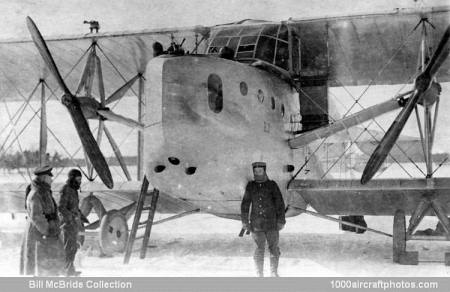01/31/2013. Remarks by Kees Kort: "The design for this Siemens Riesenflugzeug (giant aeroplane) was from the Steffen brothers, Bruno and Franz. They designed a massive biplane with engines inside the fuselage driving the propellers, which were mounted between the wings, by a system of rods and cogs. A special feature which makes the Steffen design recognizable is the split-fuselage which tapers at the end holding the rudder section. The Steffen brothers were of the school of gradual development and refinement, which made the series of seven Siemens-Schuckert Werke (SSW) R-planes, identified as R.I till R.VII, all slightly different.
The picture shows the last machine in this series, the R.VII which got the Militärzulassungsnummer (military serial) R.7/15 in the German army system. The span of this massive machine was 124 ft 8.1 in (38 m), engines were three 260 hp Benz D.IVa mounted in the nose section. These engines were more powerful than the engines used in the other SSW R-planes, which necessitated an extensive reconstruction of the fuselage to strengthen it. First flight was on January 15, 1917.
After acceptance the machine took off from Döberitz, ca. 12.5 mls (20 km) west of Berlin, to fly to Vilnius, Lithuania, in several stages, starting February 14, 1917. The picture shows the machine in what may have been an emergency landing. It arrived on February 26 in Vilnius and joined with Rfa 501 (Riesenflugzeugabteilung, giant aeroplane division). The machine participated in bombing missions during the summer of 1917. After Rfa 501 left for the Western Front the R.VII was used at Vilnius for training flights, where it existed at least till January 1918." Another view (site files)
